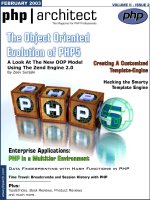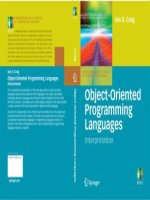evolution of programming languages
Bạn đang xem bản rút gọn của tài liệu. Xem và tải ngay bản đầy đủ của tài liệu tại đây (328.52 KB, 27 trang )
CS2403 Programming Languages
Evolution of Programming
Languages
Chung-Ta King
Department of Computer Science
National Tsing Hua University
(Slides are adopted from
Concepts of Programming Languages
, R.W. Sebesta;
Modern Programming Languages: A Practical Introduction,
A.B. Webber)
2
Consider a Special C Language
No dynamic variables
All variables are global and static; no malloc(), free()
int i,j,k;
float temperature[100];
void init_temp() {
for (i=0; i<100; i++) {
temperature[i] = 0.0;
}
}
How to program? How about hash table? binary tree?
If, in addition, no
type-define, then
you pretty much
have the first high-
level programming
language: FORTRAN
If, in addition, no
type-define, then
you pretty much
have the first high-
level programming
language: FORTRAN
Problems: developing large programs, making errors,
being inflexible, managing storage by programmers, …
3
Outline
Evolution of Programming Languages (Ch. 2)
Influences on Language Design (Sec. 1.4)
Language Categories (Sec. 1.5)
Programming Domains (Sec. 1.2)
4
The Dawn of Modern Computers
Early computers (40’s and early 50’s) are
programmed using machine code directly:
Limited hardware; no FP, indexing, system software
Computers more expensive than programmers/users
Poor readability,
modifiability,
expressiveness
Describe computation
flows
Mimic von Neumann
architecture
5
Early Programming
Programmers have to enter machine code to
program the computer
Floating point: coders had to keep track of the
exponent manually
Relative addressing: codes had to be adjusted by
hand for the absolute addresses
Array subscripting needed
Something easier to remember than octal opcodes
Early aids:
Assembly languages and assemblers: English-like
phrases 1-to-1 representation of machine instructions
Saving programmer time became important …
6
Fortran
First popular high-level programming language
Computers were small and unreliable
machine efficiency was most important
Applications were scientific
need good array handling and counting loops
"The IBM Mathematical FORmula TRANslating
System: FORTRAN", 1954: (John Backus at IBM)
To generate code comparable with hand-written code
using simple, primitive compilers
Closely tied to the IBM 704 architecture, which had
index registers and floating point hardware
7
Fortran
Fortran I (1957)
Names could have up to six characters, formatted
I/O, user-defined subprograms, no data typing
No separate compilation (compiling “large” programs
– a few hundred lines – approached 704 MTTF)
Highly optimize code with static types and storage
Later versions evolved with more features and
platform independence
Almost all designers learned from Fortran and
Fortran team pioneered things such as scanning,
parsing, register allocation, code generation,
optimization
8
FORTRAN and von Neumann Arch.
FORTRAN, and all other
imperative languages
,
which dominate programming, mimic von
Neumann architecture
Variables memory cells
Assignment statements data piping between
memory and CPU
Operations and expressions CPU executions
Explicit control of execution flows
Efficient mapping between language and HW
efficient execution performance, but limited by
von Neumann bottleneck
9
FORTRAN Programming Style
Global view, top down
Program starts from first
executable statement and
follow a sequential flow
with go-to
Conceptually, a large
main() including
everything but without
main() declaration,
though FORTRAN has functions
Match a flow chart with traces
i<N
i=0; f=0;
f = f + c[i]*x[i];
i = i+1;
N
Y
f = 0;
Problems: developing large programs, making errors,
being inflexible, managing storage by programmers, …
10
Functional Programming: LISP
AI research needed a language to
Process data in lists (rather than arrays)
Symbolic computation (rather than numeric)
John McCarthy of MIT developed LISP (LISt
Processing language) in 1958
A LISP program is a list:
(+ a (* b c))
List form both for input and for function
Only two data types:
atoms
and
lists
11
LISP
Example: a factorial function in LISP
Second-oldest general-purpose programming
language still in use
Ideas, e.g. conditional expression, recursion, garbage
collection, were adopted by other imperative lang.
(defun fact (x)
(if (<= x 0)
1
(* x (fact (- x 1)))
)
)
12
LISP
Pioneered
functional programming
Computations by applying functions to parameters
No concept of variables (storage) or assignment
Single-valued variables: no assignment, not storage
Control via recursion and conditional expressions
Branches conditional expressions
Iterations recursion
Dynamically allocated linked lists
13
First Step Towards Sophistication
Environment (1957-1958):
FORTRAN had (barely) arrived for IBM 70x
Many other languages, but all for specific machines
no universal lang. for communicating algorithms
Programmer productivity became important
ALGOL: universal, international, machine-
independent (imperative) language for
expressing scientific algorithms
Eventually, 3 major designs: ALGOL 58, 60, and 68
Developed by increasingly large international
committees
14
Issues to Address (I)
Early languages used
label-oriented control
:
ALGOL supports sufficient
phrase-level control
,
such as if, while, switch, for, until
structured programming
Programming style:
Programs consist of blocks of code: blocks
functions files directories
Bottom-up development possible
Easy to develop, read, maintain; make fewer errors
GO TO 27
30 IF (A-B) 5,6,7
15
Issues to Address (II)
ALGOL designs avoided special cases:
Free-format lexical structure
No arbitrary limits:
Any number of characters in a name
Any number of dimensions for an array
Orthogonality
: every meaningful combination of
primitive concepts is legal—no special forbidden
combinations to remember
Each combination not permitted is a special case that
must be remembered by the programmer
16
Example of Orthogonality
By ALGOL 68, all combinations above are legal
Modern languages seldom take this principle as
far as ALGOL expressiveness vs efficiency
Integers Arrays Procedures
Passing as a parameter
Storing in a variable
Storing in an array
Returning from a procedure
17
Influences
Virtually all languages after 1958 used ideas
pioneered by the ALGOL designs:
Free-format lexical structure
No limit to length of names and array dimension
BNF definition of syntax
Concept of type
Block structure (local scope)
Compound stmt (begin end), nested if-then-else
Stack-dynamic arrays
Call by value (and call by name)
Recursive subroutines and conditional expressions
18
Beginning of Timesharing: BASIC
BASIC (Beginner’s All-purpose Symbolic
Instruction Code)
Kemeny & Kurtz at Dartmouth, 1963
Design goals:
Easy to learn and use for non-science students
Must be “pleasant and friendly”
Fast turnaround for homework
Free and private access
User time is more important than computer time
First widely used language with time sharing
Simultaneous individual access through terminals
19
Everything for Everybody: PL/I
IBM at 1963-1964:
Scientific computing: IBM 1620 and 7090, FORTRAN
Business computing: IBM 1401 and 7080, COBOL
Scientific users began to need elaborate I/O, like in
COBOL; business users began to need FP and arrays
The obvious solution
New computer to do both IBM System/360
Design a new language to do both PL/I
Results:
Unit-level concurrency, exception handling, pointer
But, too many and too complex
20
Beginning of Data Abstraction
SIMULA
Designed primarily for system simulation in University
of Oslo, Norway, by Nygaard and Dahl
Starting 1961: SIMULA I, SIMULA 67
Primary contributions
Co-routines
: a kind of subprogram
Implemented in a structure called a
class,
which
include both local data and functionality and are the
basis for data abstraction
21
Object-Oriented Programming
Smalltalk: Alan Kay, Xerox PARC, 1972
First full implementation of an object-oriented
language
Everything is an object: variables, constants,
activation records, classes, etc.
All computation is performed by objects sending and
receiving messages
Data abstraction, inheritance, dynamic type binding
Also pioneered graphical user
interface design
Dynabook (1972)
22
Programming Based on Logic: Prolog
Developed by Comerauer and Roussel
(University of Aix-Marseille) in 1972, with help
from Kowalski (University of Edinburgh)
Based on formal logic
Non-procedural
Only supply relevant facts (predicate calculus) and
inference rules (resolutions)
System then infer the truth of given queries/goals
Highly inefficient, small application areas
(database, AI)
23
Logic Languages
Example: relationship among people
Features of
logic languages
(Prolog):
Program expressed as rules in formal logic
Execution by rule resolution
fact: mother(joanne,jake).
father(vern,joanne).
rule: grandparent(X,Z) :- parent(X,Y),
parent(Y,Z).
goal: grandparent(vern,jake).
24
Genealogy
of
Common
Languages
(Fig. 2.1)
25
Summary: Application Domain
Application domains have distinctive (and
conflicting) needs and affect prog. lang.
Scientific applications: high performance with a large
number of floating point computations, e.g., Fortran
Business applications: report generation that use
decimal numbers and characters, e.g., COBOL
Artificial intelligence: symbols rather than numbers
manipulated, e.g., LISP
Systems programming: low-level access and
efficiency for SW interface to devices, e.g., C
Web software: diff. kinds of lang. markup (XHTML),
scripting (PHP), general-purpose (Java)









